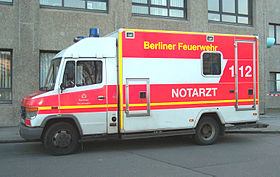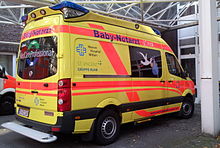emergency
|
|
|
|---|---|
| Vehicle data
|
|
| Abbreviation: | NAW |
| Crew: |
Germany: Emergency doctor, paramedic / paramedic, suitable driver Austria: Emergency doctor, paramedic, another employee |
| Commitment: | acute emergencies with an emergency doctor indication |
| Furnishing: | DIN EN 1789 Type C: Mobile Intensive Care Unit |
The emergency ambulance (NAW) is a vehicle used by the rescue service . It is used for the preclinical care of emergency patients who require medical assistance, as well as their transport to a hospital .
Definition and usage
The ambulance is a special ambulance that serves as a feeder for the doctor and, if necessary, can also transport the patient to the hospital at the same time. He is often stationed at hospitals that also provide the emergency doctor . This type of use is called a compact system . In addition, every normal ambulance (RTW) becomes an ambulance as soon as a doctor with a certificate of qualification for the rescue service as part of the rendezvous system gets on and accompanies the patient transport (mostly primary missions , in rare cases also secondary missions ). The emergency doctor's vehicle (NEF), which is often used in the latter case, only serves as a feeder vehicle with additional equipment and must be strictly distinguished from the NAW. Emergency ambulances and ambulances always meet the DIN EN 1789 type C standard, emergency vehicles do not.
In many cases, after successful emergency medical care, it is not necessary for the emergency doctor to accompany the patient during the transport to the hospital. Then the NAW team can hand the patient over to an ambulance crew and report back ready for action.
The advantage of the compact system lies in the fact that there are well-rehearsed teams of emergency doctors and paramedics or paramedics. With the rendezvous system, on the other hand, the ambulance always meets different ambulance crews. In addition, the NAW vehicles are usually a bit larger and better equipped. If the emergency doctor is not busy, the costs of an additional driver for the NEF can be saved in this way, which is why in some rural regions ambulances also drive at night with a doctor than NAW.
The disadvantage of the compact system is mainly the higher frequency with appropriate use cost as a NAW always ambulance plus paramedic and another person ( paramedic or emergency medical or emergency medical technician is busy). In addition, the large NAW vehicles are significantly slower than smaller NEF vehicles. Above all, this is a decisive disadvantage in rural areas with longer journeys, which is why NAW are particularly used in metropolitan areas or large cities.
Due to the higher costs, the compact system was replaced by the rendezvous system in many places in Germany and Austria. In Berlin, for example, all NAWs were replaced by NEF between around 2002 and 2008.
Furnishing
The minimum equipment is regulated throughout Europe by the standard DIN EN 1789 Type C (see equipment of an ambulance). In contrast to the ambulance, the ambulance usually has other medication (e.g. narcotics , antidotes ) and additional equipment (e.g. syringe pump or capnometry ) on board, which the emergency doctor uses.
In addition, there are baby ambulances with equipment specifically designed for the transport of newborns and infants. For example, there is a transport incubator in it .
Germany
staff
The crew of the NAW consists of an emergency doctor , an emergency paramedic or paramedic and another employee whose qualifications are different in each federal state .
history
During the time of the so-called mirror rescue (without patient care, only one driver on the vehicle who monitors the patient in the rearview mirror) in the 1950s, it was partly recognized that emergency patients were at least by a well-trained paramedic on site, if not even should be treated by a doctor instead of the ambulance service acting as a recumbent taxi. In February 1957, an experiment was started at the University of Heidelberg in which a coach (the Clinomobil ) converted into a mobile operating theater with medical staff drove up to emergencies. The size of the vehicle, however, proved impractical. In the same year, the first West German ambulance went into the test phase in Cologne . Due to the smaller size of the vehicle compared to Heidelberg, more successes were recorded here, so that the Cologne NAW went into permanent service on June 3, 1957.
Emergency rescue was also promoted on the territory of the GDR . At the initiative of Werner Lembcke , a NAW was put into service on January 21, 1960 at what was then the Magdeburg Medical Academy . This was manned by anesthetists from the Academy and drove the progress of emergency rescue. In 1967, 46 ambulances were already in operation in the GDR. With the introduction of the tiered system of rapid medical aid in 1976, the system gradually changed over to a deployment tactic that corresponds to today's rendezvous system .
Austria
staff
In Austria, NAWs are usually manned by an emergency doctor, at least one emergency paramedic (NFS) and one other paramedic. Many of the NCCRs used at the NAW have the additional emergency competence NKA, NKV or NKI. A third paramedic or trainee can take fourth place at the NAW. In Vienna, fourth place is often occupied by civil servants or volunteers who are trained as paramedics . Many of the full-time drivers at the NAW are now also NFS.
history
The Viennese professional rescue service was founded in 1881 after the fire in the Vienna Ring Theater . Since the beginning of the organized Viennese rescue service, doctors have been deployed in the rescue service, while in all other federal states medical participation was not stipulated or organized. On February 1, 1974, the first ambulance was stationed in Linz , jointly by the Red Cross and the city of Linz. Most emergency medical centers in Austria were founded in the 1980s. The basic and advanced training for emergency doctors, which has been mandatory since 1987, and the professional profile of paramedics / emergency paramedics form the basis for a qualified emergency doctor system in Austria.
See also
literature
- Claudia Bartelke: Emergency ambulance in the Federal Republic of Germany: A study of the organization and equipment of this rescue equipment (carried out from August 1973 to July 1974). Johannes Gutenberg University Mainz , Mainz 1977.
- Manfred Gihl: Ambulance vehicles: from the ambulance to the ambulance. Kohlhammer, 1986.
Web links
Individual evidence
- ↑ Ministry of the Interior, for Sport and Infrastructure of the State of Rhineland-Palatinate: State Law on Ambulance Service and Emergency and Ambulance Transport , 2007 .
- ^ "Unterdruck", district group fire brigade in the police union, special edition June 2007 [1]
- ↑ Christian Jung: 50 years of the ambulance: When every minute counts. Spiegel Online , April 20, 2014.



